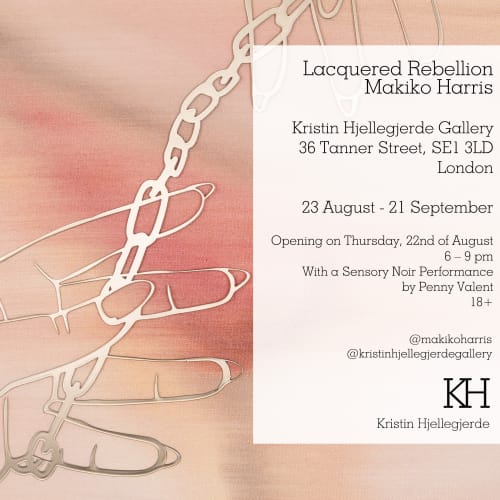Private View: LACQUERED REBELLION: Kristin Hjellegjerde Gallery, London
Current event
Overview
Private View: Thursday, the 22nd of August 2024, 6-8pm
London (Tower Bridge)
Oversized fingernails, giant knitting needles, chains and aluminum stockings. These are all recurring motifs in the work of American Japanese artist Makiko Harris whose practice explores the performance of identity, femininity and ideas of belonging. Lacquered Rebellion, her first solo exhibition at Kristin Hjellegjerde Gallery, brings together a bold new collection of sculptures and mixed-media paintings that unravel Harris’s own experiences as a biracial woman while also reflecting on the ambiguities of contemporary feminism.
While studying for her MA at the Royal College of Arts in London, Harris inherited her Japanese grandmother’s sewing kit containing a variety of needles which had been used not only to make clothes but as a form of creative self-expression. Fascinated by the intimacy and tactility of these tools as well as their relationship to the feminist history of textile arts, Harris began to reimagine the needles at a monumental scale. The resulting sculptures, ranging from one to two metres tall, take on an almost figurative presence, simultaneously fragile and confronting, elegant and brutal. They are weapons in the fight towards reparation, creativity and feminist power.
Meanwhile, sculptures of painted fingernails similarly blown up to a larger-than-life scale, balancing in space or attached to the edges of painted canvases evoke the appearance of shields. Like the needles, they are tactile objects which are associated not only with the female body but with a certain type of femininity – one that is required to comply with patriarchal ideals. And yet, Harris’ nails are not passive accessories: as sculptures they are both armour and body while in the paintings they enact a form of powerful self-possession, gripping what appears to be abstracted, oozing flesh.
This juxtaposition between vulnerability and strength, sensuality and violence, exposure and censorship is also articulated in Harris’ Stockings series. In these works, fleshy body parts bulge suggestively against what appears from a distance to be fish-net tights but on closer inspection, the netting reveals itself to be a kind of rigid armour, made of galvanized steel. In this way Harris both articulates women’s ongoing struggle for agency while also reclaiming narratives that fetishize stereotypes of submissiveness and compliance around Asian women. As such, the fish-net stockings become not just a symbol of self-empowerment but one of rebellion in which the sensuality of the female body is both reclaimed and heightened for women’s own pleasure.
A series of mixed-media paintings encompassing metal plates and chains further plays on ideas of fetish, control and weaponized femininity. Here again, the hard, shiny surface of metal appears in contrast to fluid, dripping brushstrokes in opaque, fleshy tones. For Harris, the chains are also symbolic of generational links and inherited identities. ‘I was taught what it is to be a woman by the women who came before me. There is a sweetness to that memory and connection to a loved one, but there is also a more sinister edge that relates to intergenerational trauma,’ she says. Significantly, in all of the works the chains are left loose and open ended, perhaps symbolising a sense of breaking free from oppressive gender expectations of the past.
Presented together, the works in Lacquered Rebellion put forth a powerful portrait of contemporary femininity, one that reclaims and subverts stereotypes to celebrate the female body and the collective liberation of sensuality and gender expression.
